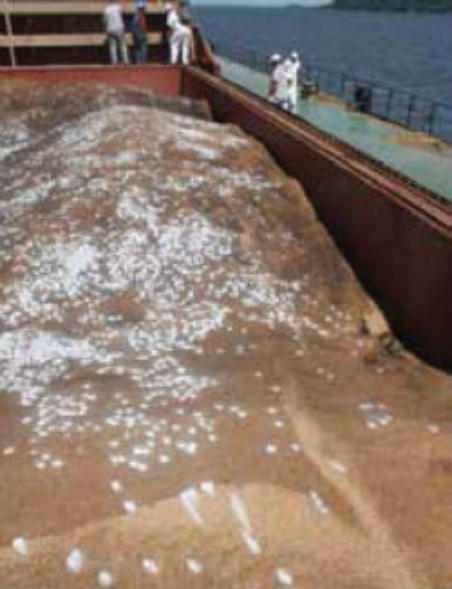201437 Disposal of aluminium phosphide residues
Edited from UK P&I Club Bulletin 957
There have been a number of accidents and injuries resulting from the release of highly toxic phosphine gas. In addition, a number of fires and explosions have been caused by the unsafe disposal of residues of aluminium phosphide following the fumigation of cargoes in transit. International guidance and recommendations on fumigation on board ships is contained in MSC Circulars 1264 and 1396 and the IMSBC Code.
While phosphine is a well established insecticide, it is also poisonous to humans at relatively low concentrations and can form flammable gas/air mixtures. Failures to follow correct application procedures include:
* Failure to unfold or uncoil belts, blankets, blister packs and ropes. This presents a fire hazard, and possibly an explosion hazard which worsens if moisture that condenses on the upper parts of the cargo space (sweating) drips onto the fumigant product. Under these circumstances a flammable phosphine:air mixture is more likely to form. If this mixture accumulates within an enclosed space such as a cargo hold or a drum fitted with a lid, it may ignite spontaneously and cause a fire.
* Too many pellets or sachets clustered together (see picture).

Disposal of fumigant residues
MSC Circular 1264 requires that ‘all waste and residues are disposed of in an appropriate manner, either by incineration or by disposal on shore, as recommended by the manufacturer. Clear written instructions must be given to the Master of the ship, to the receiver of the cargo and to the authorities at the discharging port as to how any residues are to be disposed of.’ Wherever possible, the collection and disposal of fumigation waste should be carried out by properly trained contractors. If residues are to be disposed of by the crew, then note:
* Dispose of waste in accordance with manufacturer’s instructions, or instructions provided by the fumigation contractors at the load port.
* Fully reacted residue is safe for disposal at a suitably approved site.
* Waste containing un-reacted material is classed as a hazardous waste and will require special care, and deactivation before disposal.
* Unless crew members have expertise in determining whether the residue contains un-reacted material, it would be prudent to treat it as though it requires deactivation before disposal, and the manufacturer’s instructions for this procedure should be carefully followed.
Avoiding accidents
* Do not pile residues onto an open deck exposed to damp or wet conditions. This may cause a fire and toxic gas hazard.
* Do not under any circumstances store residues in a closed drum or other sealed container. This may result in an explosion if a flammable phosphine:gas:air mixture ignites spontaneously, accompanied by the continuing escape of toxic phosphine gas.
* Do not store residues in an open drum exposed to damp or wet conditions.
* Do not place an open drum of waste in a compartment or locker, such as a forecastle store, because of the risk of build-up of phosphine in the space.
Phosphide fumigants can be hazardous, but by carefully following the guidance and warnings in MSC Circulars 1264 and 1396, and the IMSBC Code and the manufacturer’s instructions for the disposal of spent or partially spent material, accidents and injury can be avoided.
